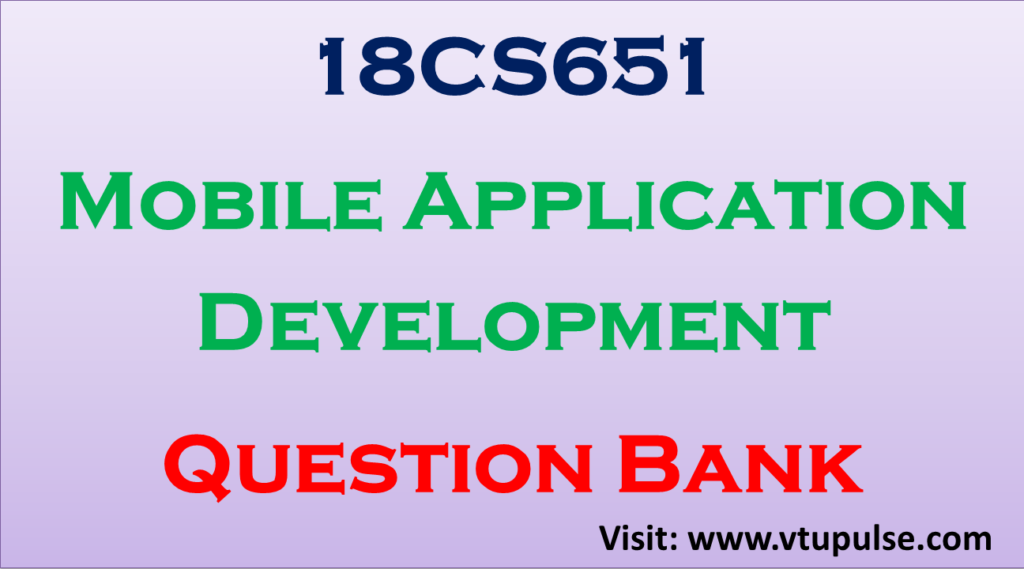18CS651 Mobile Application Development Question Bank
Here you can find the module wise question bank of 18CS651 Mobile Application Development for VTU examination.

18CS651 Mobile Application Development (MAD) VTU CBCS Notes
Module -1
1. Define Android? Explain Android Architecture with neat diagram?
2. List and Explain the challenges of Android app development?
3. Explain the Android app development process with neat diagram?
4. Explain the Android app build process ?
5. Explain with a neat diagram model-view-presenter pattern?
6. List and Explain different layout view group?
7. List the Android App Components? Explain Activity Component?
8. Define Intent? Explain different types of Intent?
9. Demonstrate with code snippet how to pass data between activities with Intent using Intent Extra?
10. Demonstrate with code snippet how to pass data between activities with Intent using Intent Data?
11. Demonstrate with code snippet how to get data back from activity (StartActivityForResult)?
12. Explain Activity Navigation?
13. Define Activity Life Cycle? Explain with neat diagram Activity Life Cycle?
14. Demonstrate the usage of Implicit Intent with Code Snippet?
15. Explain the process of Debugging?
16. Define Testing? Explain types of tests?
17. Write a test case for adding two numbers using JUnit 4?
18. Explain the features of The Android Support Library.
Module – 2
1. Define Input Control? Explain different types of Button and its states?
2. Explain button-listener design pattern with neat diagram?
3. List and Explain callback methods defined in the event listener interfaces to handle?
4. List the different input controls for making choices? Demonstrate with a code snippet the usage of RadioButton?
5. Demonstrate with a code snippet the usage of Checkbox?
6. Demonstrate with a code snippet the usage of Switches?
7. Define Spinner? Demonstrate with a code snippet the usage of Spinner?
8. Define Dialog? Demonstrate with a code snippet the usage of Alert Dialog?
9. Define Pickers? Demonstrate with a code snippet the usage of Date Picker?
10. Define Menu? Explain different types of menus?
11. Define Touch Gesture? Explain how to detect common gestures?
12. Define App bar? Explain four different functional areas of App bar?
13. Demonstrate with code snippet to create options menu?
14. List and Explain app:showAsAction attribute values?
15. Define Contextual menu and Explain different types of Contextual menu?
16. Demonstrate with code snippet the usage of Floating context menu ?
17. Define Pop-up menu?Explain a process Creating a pop-up menu with neat diagram?
18. Explain different types of Hierarchical navigation patterns?
19. Define RecyclerView? Demonstrate with a code snippet the usage of RecyclerView?
20. Define Testing? Explain Manual Testing and Automated Testing?
Module – 3
1. Explain Android Thread Rules?
2. Demonstrate with a code snippet the usage of AsyncTask with connecting to Internet and downloading image?
3. Explain the need of Async Task and its call back methods?
4. Explain AsyncTask parameters with example?
5. Explain the Limitation of AsyncTask?
6. Define Loader? Explain the different call back method of LoaderManager class?
7. Explain the purpose of BroadCast Intent?
8. Explain the different types of BroadCast Intent?
9. Define BroadCast Receiver? Demonstrate the usage of BroadCast Receiver to respond to the broadcasted messages?
10. Explain the two ways of registering the Brodcast receiver?
11. Define Services? Explain types of Services?
12. With a neat diagram explain the life cycle of Services?
13. Differentiate between started service and bound service?
14. Define Notification? Explain the steps involved in creating and setting notification?
15. Explain the various optional components used with notification?
16. Define Alarams? Explain the characteristics of Alarams?
17. Explain the types of Alarams?
18. With a neat diagram explain the states of Wireless Radio?
19. Explain Prefeching with example?
20. Define Job Scheduler? Explain the different components of ob Scheduler?
Module – 4
1. List the various options provided by the android system to store the application data persistently?
2. Differentiate between the two file storage areas?
3. Demonstrate with code snippet writing and reading to the file of Internal Storage?
4. Define Shared Preferences? Differentiate between Shared Preferences and Saved Instance State?
5. Demonstrate with Code Snippet the usage of Shared Preferences?
6. Define and List the Characteristics of SQLite database?
7. Define Traction? Explain ACID properties?
8. With an Example explain the queries for Android SQLite?
9. Justify why SQLite database is better option of Storing the data?
10. Explain the need of Cursors?
11. Explain processing of Cursors with an example?
12. Explain Database operations with neat diagram?
13. Define Content Provider? Explain with an example sharing the data between application using Content Provider?
14. Explain the Advantages of Content Provider?
15. With a neat diagram explain the app architecture with Content Provider?
16. Demonstrate with code snippet of database operation with SQLite database?
Module – 5
1. Define Permission and Explain why it is needed and its types?
2. Explain the various ways to maximize the app performance?
3. Describe how to Monitor the performance of running app?
4. Explain best practices to keep the user data secure?
5. With an example explain firebase real-time database and how the data is stored in it?
6. Demonstrate with code snippet reading and writing the data into firebase?
7. Explain AddMob?
8. Explain the steps to implement the AddMob in Application?
9. Define APK? Explain the steps involved in Preparing App for release ?
10. Explain the tasks involved in Publishing the app in Google play store?
Follow the below link to download the 2018 scheme VTU CBCS notes of 18CS651 Mobile Application Development.
Here you can find the question bank of the 2018 scheme VTU Mobile Application Development (MAD). If you like the material share it with your friends. Like the Facebook page for regular updates and YouTube channel for video tutorials.
